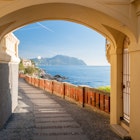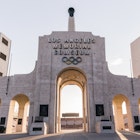The Italian Lakes are glimmering, glacier-made bodies of water in northern Italy. Maggiore, Como and Garda are the three largest, and each is ringed with picturesque villages and backed by steep mountains.
The biggest reason to visit is the spectacular scenery, but there's lots more to do besides admiring the views from a shoreline dining room. You can explore historic villas – and the grand gardens that surround them – visit castles and Roman ruins, and get your nature fix on kayaking tours, mountain biking excursions and hilltop hiking trails.
Here's all you need to know for your first visit to this incredible region of Italy.
When should I go to the Italian Lakes?
The summer has obvious appeal, with long warm days and a packed calendar of big events and festivals. On the downside, the lakes overflow with visitors between June and early September. You'll have to contend with higher accommodation prices, congested roads and sizable tour groups filtering through the prettiest villages.
You can beat the worst of the crowds and still enjoy pleasant weather by coming in May or October. Winter sees few visitors, and some restaurants, hotels and key attractions shut down for the season. Nevertheless, with careful planning, winter can be a magical time to visit if you don't mind the cold.
Some lake towns, like Cernobbio on Lake Como and Riva on Lake Garda, are quite festive in December with holiday lights, Christmas markets and special activities for kids.

Is it easy to get around the Italian Lakes?
It's entirely possible to go green and do without a car. You can catch a train to gateway towns on each of the lakes. Once there, a handy ferry system links key destinations. Buses help fill in the gaps for shorter journeys. If, on the other hand, you have a more ambitious itinerary and want to explore the mountains above the lakes, a car will give you more freedom. Just keep in mind that the roads are narrow and parking can be difficult, especially on summer weekends.
How much time should I spend at the Italian Lakes?
You'd need more than a month just to see the highlights of this region, given the large size of these lakes and the wide range of attractions found along their shores. Rather than trying to pack everything into one whirlwind visit, plan a more manageable itinerary.
If you have just a weekend to spare, pick one lake and narrow your focus: outdoor activities in Riva del Garda, for instance; exploring lovely Bellagio and Varenna in Lake Como; or visiting the islands and villas of Lake Maggiore near Stresa and Verbania.
If you have a week, you can combine a couple of these itineraries, or focus on a more complete lake journey – perhaps even adding another country into the mix. Southern Switzerland contains the north end of Lake Maggiore, as well as yet another enchanting lake: Lugano.
Top things to do at the Italian Lakes

Lake Maggiore
Lake Maggiore is best known for its trio of islands. From Stresa or Verbania, catch the boat over to Isola Bella for a wander through Palazzo Borromeo. The grand mansion dates back to the 17th century, with lavishly decorated rooms full of artwork by old masters – including Van Dyck, Titian and Rubens. The baroque gardens out back, complete with strutting peacocks, are equally captivating.
For lunch, take the boat over to Isola Pescatori and have a meal at one of the lakeside restaurants – Casa Bella is superb for its creative Italian fare. Afterward, continue to Isola Madre to visit another palatial house and its gardens – this one full of exotic plant species from across the globe.
Lake Como
Over at the next big lake, make the town of Como your base, and take a scenic walk along the Chilometro della Conoscenza (kilometer of knowledge). The lakeside promenade takes you through verdant gardens and past three photogenic villas, with memorable shoreline views along the way.
Afterward, check out the historic sites in town – a grand cathedral and several medieval churches – then set out through the cobblestone lanes of the center, which are dotted with indie shops and boutiques, wine bars and terrace cafes. Don't miss the funicular ride from Como up to Brunate for stunning views across the mountains. This is also a prime hiking destination, with numerous trails crisscrossing the area.
Near the center of Lake Como, you can make a day trip to three picturesque villages. Start in Varenna, a beguiling waterfront settlement with its pastel-hued houses and narrow lanes. Make the 25-minute walk up to Castello di Vezio for a view over the rooftops and shimmering Lake Como beyond. A short boat ride from Varenna, Bellagio is another charmer with its hilly pedestrian lanes lined with galleries and flower-trimmed restaurants. It's delightful to explore on foot, though you can also join a kayaking tour with Bellagio Water Sports for a unique perspective from the water.
Cap the day with a trip to Menaggio on Como's western shore. The tiny village has a few cobblestone streets that invite exploration and a water-facing piazza that's perfect for an aperitivo (a pre-dinner drink). Cafè del Pess is a perennial favorite spot for an al fresco campari spritz.
Lake Garda
Lake Garda has some of the most significant ruins of the Italian lakes. On a finger-like peninsula near the south end, the gorgeous town of Sirmione is home to several historic sites. The Grotte di Catullo was once a sprawling villa during the 1st century AD, and it's easy to imagine its grandeur while wandering amid the ruins on the hillside. Fast forward through the ages to the Rocca Scaligera, a remarkably well-preserved square-cut castle dating from the 14th century. You can walk the battlements for a view of the water that surrounds the castle on all four sides. In the evening, head to the Aquaria Thermal Spa and relax amid steaming open-air pools with views over the lake.

My favorite thing to do in the Italian Lakes
I love to head to Riva del Garda for mountain biking adventures. One of the best rides I've ever taken is along the Via Ponale (aka Strada del Ponale), a 10km-long dirt road that snakes along cliff faces and ducks into tunnels as it veers ever higher to yet more astonishing views over the lake. It's well-signed, and there are good places to refuel, including Ponale Alto Belvedere, where you can enjoy a drink on the terrace to an unrivaled backdrop.
I like to get an early start and pedal all the way up to Lago di Ledro, where I can cool off with a swim. You once needed quads of steel to make such a steep journey, but nowadays, you can hire a quality e-bike that takes the bite out of the hills. Outfitters in town rent e-bikes, including the excellent Happy Bike.
How much money do I need for the Italian lakes?
The Italian Lakes can be expensive, especially if you come during the summer when lodging prices are at a premium. You can save money by foregoing a car rental and staying at hostels and simple guesthouses. You can also economize on meals (well, the occasional meal) by skipping the multi-course dining experience and eating at markets and simpler cafes.
Daily costs
- Hostel room: €48 (US$53)
- Basic room for two: from €140 (US$153)
- Self-catering apartment (including Airbnb): from €110 (US$120)
- Ferry ticket from Varenna to Bellagio: €4.60 (US$5)
- Train ticket from Milan to Como: €5.20 (US$5.70)
- Cappuccino: €2.50 (US$2.75)
- Pizza (individual): from €12 (US$13)
- Dinner for two: from €100 (US$109)
- Spritz (or other cocktail): €8 (US$8.75)
What's the best way to get to the lakes?
Milan has excellent train service to the lakes from various stations, including the architecturally striking Stazione Centrale. Approximate journey times by train from Milan are as follows: Como (one hour), Laveno Mombello Lago on Lake Maggiore (1.5 hours), Desenzano del Garda on Lake Garda (1.5 hours).

Where can I rent a boat?
Various outfitters at each of the lakes rent out motorboats. No special license, apart from a driver's license, is required for watercraft up to 40hp. Como Lake Boats near the north end of the lake offers excellent service and some of the most competitive prices (which are higher around more popular areas like Bellagio and Menaggio).
Rates start around €130 ($142) for two hours and €180 (US$196) for four hours, with slight discounts for longer rentals. You'll also pay for whatever fuel you used at the end.
What are the beaches like on the Italian Lakes?
The beaches around the lakes are rocky, with small to medium-sized stones. Sometimes, these are backed by grassy lawns, perfect for stretching out and having a picnic. If you have your heart set on sandy beaches, however, these lakes are not a good choice.












